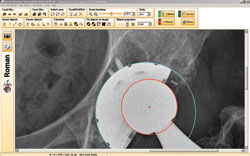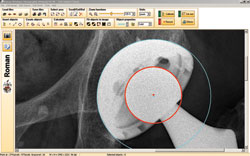Better long-term wear resistance seen with crosslinked polyethylene for THA
A 13-year follow-up study conducted by investigators from the Netherlands showed that total hip arthroplasty performed with an annealed, crosslinked polyethylene insert resisted wear better over time and had less osteolysis than using a conventional polyethylene insert.
“The crosslinked [polyethylene] PE, even the annealed version with some residual free radicals, maintained wear resistance in the long term and produced less osteolysis,” Bernd P. Grimm, PhD, said during his presentation at the 12th EFORT Congress 2011. “Now for us, the crosslinked PE is the new standard and we can expect that maybe the highly crosslinked PE may also perform well.”
Grimm noted that researchers had theorized that using crosslinked polyethylene may produce free radicals, which could lead to accelerated wear or osteolysis.
|
Images: Grimm BP |
“When we crosslink, we produce free radicals that may cause oxidation which then may lead to accelerated wear and maybe again to osteolysis or maybe damage such as rim fracture,” Grimm said. “There is also the theory that crosslinked particle debris is of a different shape — smaller — and maybe more frequent, and therefore, has higher osteolytic potential.” If so, some theorize that this may produce more osteolysis despite less wear volume. “But, maybe in the long term, wear accelerates and we get higher osteolysis,” Grimm said.
Prospective, randomized study
Grimm and colleagues conducted a prospective, randomized study of 48 patients who underwent primary total hip arthroplasty (THA). Of the 31 patients available for review, 13 received Stryker’s first generation PE material (Duration; Kalamazoo, Mich.) and 18 received a then considered conventional PE that was gamma irradiated in air.
Average follow-up was 13 years. The researchers used the Harris Hip score and anteroposterior (AP) and lateral radiographs to measure outcomes. They analyzed wear with Roman version 1.70 and osteolysis using the DeLee Charnley zones on AP and lateral radiographic views.
Reduced wear
|
|
There was no statistical significance between groups regarding age, gender, body mass index, stem and cup size, cup inclination or preoperative and postoperative Harris Hip scores. Insert material was the only variable, according to Grimm.
The crosslinked PE performed better with an annual wear rate wear rate of 0.063 mm/year compared with 0.122 mm/year for the conventional PE. The -48% reduction in wear for the crosslinked group was comparable to the simulated prediction of -45%.
“The wear reduction has increased with time so we do not have accelerated wear, and we do not see an effective oxidation on the wear rate,” Grimm said.
One patient in the crosslinked group was above the osteolysis threshold of greater than 0.01 mm/year compared with 10 patients in the conventional group.
The investigators also found significantly less total linear head penetration in the crosslinked group compared to the conventional group (0.7 mm vs. 1.56 mm). The acetabular wear rate was also lower on radiographic analysis in the crosslinked group compared to the conventional group. – by Renee Blisard
Reference:
- Grimm B, Tonino A, Heyligers I. Long-term reduction of wear and osteolysis with crosslinked PE? 13-year follow-up of a prospectively randomized comparison with conventional PE. Presented at the 12th EFORT Congress 2011. June 1-4. Copenhagen, Denmark.

- Bernd P. Grimm, PhD, can be reached at the AHORSE Research, Atrium Medisch Centrum Parkstad, Department of Orthopedic Surgery, Heerlen, CX, Netherlands; 49 (0)163 6 99 43 56; email: bpl.grimm@gmail.com.
- Disclosure: Grimm receives educational funding from and is a paid consultant for Stryker. Heyligers is also a paid consultant for Stryker.
There is no doubt that we have made great strides in addressing the issue of wear in total hip arthroplasty (THA). Introduction of highly crosslinked polyethylene (XLPE) is perhaps one of the greatest advancements in total joint arthroplasty. Although many issues regarding alternative bearing surfaces (including XLPE) exist, the orthopedic community unanimously embraces the notion that XLPE has reduced wear rate in patients undergoing THA at least in the short to medium term.
The study by Grimm et al entitled, “Long-term reduction of wear and osteolysis with crosslinked PE. 13-years follow-up of a prospectively randomized comparison with conventional PE,” is taking a step to assure us that XLPE performs well even in the longer term. In their prospective study, Dr. Grimm and colleagues randomized 48 patients to receive either Duration PE (what they call XLPE) or conventional PE. At 12.9 years follow-up of the 31 patients that could be located, wear rate (measured using Roman V1.70) was significantly (roughly 48%) less in the Duration group than the conventional polyethylene. In addition, the incidence of periacetabular osteolysis/cyst was much lower in the Duration group than the conventional PE.
Although a large number of their patients (>35%) were lost to follow-up, which is almost inevitable with long-term studies, they were able to demonstrate a difference in performance of Duration PE. The study, however, carries a misleading title. The Duration PE that is being compared with conventional PE is not however — by any stretch of imagination — a highly crosslinked PE, which may explain why the wear rate for Duration is still considerably higher than the current XLPE. The major difference between the two PEs being compared in this study is that one was irradiated in an inert gas (nitrogen) and annealed vs. the other PE that was irradiated in air. The dose received were the same at 3MRad. I am sure the authors realize that the current day XLPE receive in the order of 10 MRad irradiation.
Thus, the concern of the orthopedic community for possible in vivo oxidation that they have also pointed out or potential for fatigue fracture is not addressed by this study. Further, some will argue that 13 years is still an early time point when assessing wear of an “alternative” bearing surfaces. Some would also raise issues with the methods for measurement of wear that they have utilized.
Despite all of these shortcomings, the authors should be applauded for conducting a level 1 study with a long term of follow-up.
— Javad Parvizi, MD, FRCS
Orthopedics Today Editorial Board member
Rothman
Institute, Philadelphia
Disclosure: Parvizi is a consultant to
Zimmer, Smith & Nephew, Stryker and Biomet.



